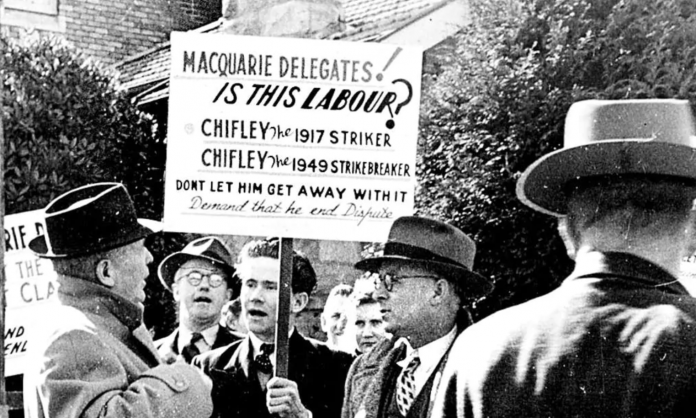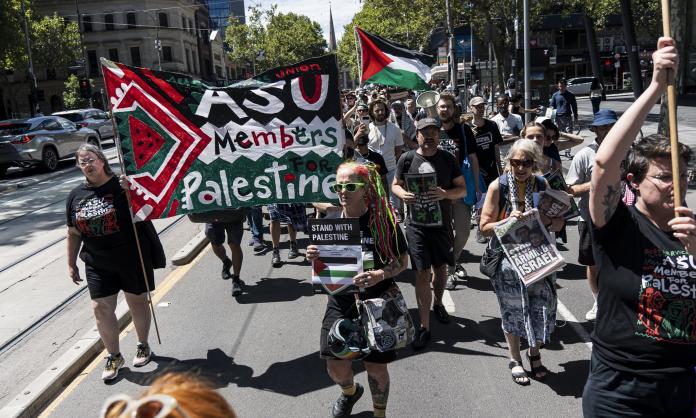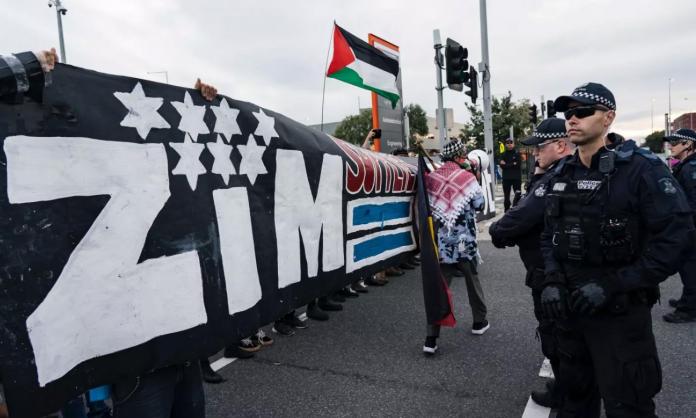“If the order is given to fire, don’t let me see any rifle pointed in the air; fire low and lay them out”, Lieutenant-Colonel Tom Price told his troops the day before confronting striking maritime workers in 1890. While no-one was shot, the action against workers continued a tradition of using troops to put down Indigenous and convict resistance and unrest in colonial Australia.
Fast forward to last month, when Prime Minister Scott Morrison refused to rule out the use of the armed forces on the wharves against workers who, he said, were “holding the country to ransom” with “straight-out extortion”. Striking workers in Australia have often been threatened with military force.
Troops were first used at the Lambton Colliery in the Hunter Valley in 1888, but their most notorious use was in the deep recession several years later, when the military was used against striking waterfront workers and shearers. In 1890, maritime strikes spread across the country. It was in Melbourne during this strike that Tom Price infamously briefed his troops to “fire low and lay them out”. A year later, the Queensland shearers’ strike led to the government declaring a state of emergency. More than 1,400 members of the Queensland Defence Force were called out to “maintain civil order and discipline” for five months. The turmoil of the 1890s led to the insertion of s.119 into the constitution, authorising the military to be mobilised against “domestic violence” amounting to an “uncontrollable situation”.
During the twentieth century, state governments requested military intervention at least six times in anticipation of such incidents, such as the riot and bloodshed during the 1912 Brisbane general strike and the 1923 Victorian police strike. All the requests were refused, though troops were sent to Melbourne to protect commonwealth buildings during the police strike and naval warships were positioned in Port Phillip Bay.
Throughout World War Two, the Curtin Labor government reacted to strikes and industrial action on the waterfront with threats and actual use of the navy and army, mainly to load and crew military ships.
Labor again used the army against workers while wartime provisions were still in force during the 1949 coalminers’ strike in the Hunter Valley. Operation Excavate brought troops to mine and transport coal, while support for the miners from other unions was criminalised. By the end of the strike, the coalminers were defeated. At the end of the year, the Chifley government lost the federal election to Robert Menzies’ Liberal and National Coalition.
Known for his rabid anti-communism, Menzies lost no time moving against the Communist Party of Australia (CPA) and communist- and left-wing-led unions. As well as two failed attempts to ban the CPA, Menzies ordered the greater use of ASIO in raids on union and CPA offices. While commitments under the new ANZUS military treaty and the rearmament program for the Korean War nearly bankrupted the country, the Coalition stepped up other military spending by introducing compulsory national service.
In the first months of 1950, Menzies and Industrial Relations minister Harold Holt set up the highly secretive Operation Alien, designed to use armed force against industrial action. This operation, under the direct control of Menzies and with a special staff of military personnel, department heads and the assistant general manager of Shell, began extensive planning to maintain essential services and preserve law and order in the expectation of massive industrial protests over any successful banning of the CPA. Between 1951 and 1954, coupled with raids, arrests and threats of deregistration, army and navy personnel were used to break Seamen’s Union of Australia and Waterside Workers’ Federation bans on at least seven occasions.
In a more spectacular fashion, Operation Alien was used at Queensland’s Bowen port in 1953. Bowen, like the four other sugar ports, was facing temporary labour shortages, and the employers were refusing to fund workers’ relocation. A combination of Senate elections, a dispute at the local crushing mill and a national waterfront dispute led to the federal government bringing in 200 troops to load the ships. It was a disaster for the government.
Bowen’s waterside workers went on strike immediately, the union threatened an Australia-wide strike, and the ACTU condemned the use of troops. Railway workers declared the wharf “out of bounds” and were supported by local meat and sugar workers. When the army commandeered the railway goods yard, the Australian Railway Union threatened action, and even the Queensland government protested. The troops were shunned in the town, and the federal government was forced to withdraw them without loading a single ship.
As early as 1954, the government supported the colonial forces in Vietnam. In April, navy and air force personnel loaded munitions onto the Radnor bound for French troops after wharfies had refused. In 1967, the Coalition commissioned the merchant ship Boonaroo when the Seamen’s Union boycotted it in opposition to the US-led Vietnam War. As public outcry against the war grew, especially in light of the My Lai massacre, Sydney waterside workers refused to unload the munitions ship Jeparit. Again, troops were used to crew and unload the ship.
In 1981, Liberal Prime Minister Malcolm Fraser authorised the use of the RAAF for the Operation Anzac airlift, transporting 2,200 travellers from New Zealand to Australia when Qantas pilots refused to scab on an Air New Zealand pilots’ strike. Just eight years later, Bob Hawke’s dramatic use of the air force to smash the 1989 pilots’ strike put Fraser’s so-called rescue mission in the shade. Hawke also changed the immigration and training regulations to allow overseas pilots and airlines to scab on Australian crews.
Giving an early warning in 1993, then Liberal leader John Hewson declared that the Coalition would use troops on the waterfront if necessary. In 1998 Prime Minister John Howard, unsure about direct use of the military, as well expecting success during the 1998 waterfront dispute, facilitated the training of former military and police in Dubai. Foiled by international trade union solidarity, the training exercise was abandoned.
While the kind of armed intervention common to more repressive states hasn’t surfaced here, the Australian state has not shied away from using force against workers. With increased militarisation, especially under the guise of anti-terrorism, it’s only a matter of time before another prime minister does more than just threaten the use of military force against striking workers.











